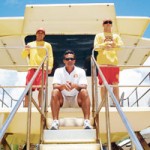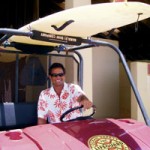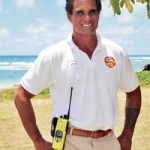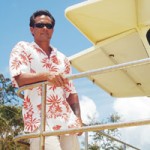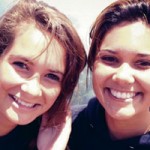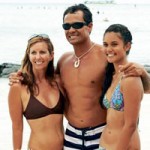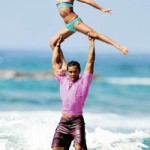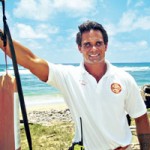Lifesaver in Chief
A former pro surfer turned his love of the ocean into a career saving lives as chief of Kauaʻi lifeguards
IT’S ALL ABOUT SAVING LIVES.
“The feeling that you get is priceless; there is no money that could get you that feeling,” says Kalani Vierra, operations chief for the Kaua‘i Fire Department Ocean Safety Bureau, of the many ocean rescues he has conducted.
One South Shore rescue he participated in several years ago still stands out in his mind. A scuba diver who was visiting the island encountered trouble at Koloa Landing and was barely breathing when he was finally loaded into the ambulance.
“I thought he was a goner,” says Vierra.
Four days later, the man called Vierra to thank him for saving his life.
“It was unreal, the best feeling you could ever get,” says Vierra.
These days Vierra, in addition to overseeing the county’s lifeguard program, also serves on the Kaua‘i Lifeguard Association board.
“Here we have no protection — it’s just wide open ocean,” he says.
The Garden Isle’s rounded shape offers hardly any protected bays, aside from Hanalei, that guard against the deep channels that run between the islands, generating exceptional wind swells. But even Hanalei sees large surf during the winter season, and it shares the highest number of rescues each year with Po‘ipu.
Luckily, there are lifeguard towers at both of these locations. In fact, there are 10 towers across the island, and Vierra oversees 45 full-time and seven part-time lifeguards.
Visitors in particular should only swim at lifeguarded beaches. Not only are they there to help protect people, the lifeguards also provide sage advice to anyone who inquires.
The most frequently asked question by visitors is regarding currents.
Coco Zickos photos
- Many of the lifeguards today participated in the Junior Lifeguard Program as keiki, a program initiated by the Kauai Lifeguard Association. Kalani Vierra with Eric Pereza (left) and Garrett Stephen
- Vierra has helped prevent the casualties and injuries of many visitors and residents
- Waterman Vierra has found his true passion saving lives
- Vierra is on the board of the Kauai Lifeguard Association
- Vierra’s daughters, Kaleigh Rutt (left) and Eliza
- Pictured with wife, Tracy, and their daughter, Eliza
- Tandem surfing with his daughter, Eliza. Photos from Vierra ohana
- Former professional surfer Kalani Vierra turned his love of the ocean into a career as a lifeguard
“And one big rule of thumb is the bigger the surf, the stronger the current,” says Vierra.
If folks must swim at non-lifeguarded beaches, Vierra suggests taking at least 20 minutes to observe the conditions before entering the water because the ocean can be deceptive.
At Anini Beach, for example, there are naturally formed currents on the reef because of the deep-water channels.
“So water comes flushing over the shallow reefs and gets sucked back out to the deeper channels,” he says.
Even though 65 percent of rescues are visitors, 35 percent of residents need regular assistance from dangerous situations. While visitors often get caught in currents swimming or snorkeling, kama‘aina encounter trouble in other ways, such as diving, fishing, surfing or picking opihi.
“I’ve been in trouble myself a couple of times, surfing in the big-wave areas and my leash breaks, or I’m stuck out there in the current and basically I have to save myself,” says Vierra.
His No. 1 recommendation for anyone caught in the current?
Stay calm. “Wave your hands to try to get assistance,” he says. “And don’t fight the current.”
While growing up, Vierra saw many people in trouble but felt helpless without the proper training. It wasn’t until after he had his second child, Eliza, that he experienced what it felt like to save lives. Vierra enrolled in CPR and first aid classes for his daughters, Eliza (15) and Kaleigh (17), so that he would know what to do in case of emergency. He continued his training with a three-week lifeguard course and never looked back.
“I really got into the class and what they had to offer, and I told myself, ‘This is what I want to do,'” he says. “What better way to enjoy the ocean and get paid for it?”
By 1999, Vierra was saving lives full time.
Prior to launching his lifeguarding career, Vierra was a professional surfer. Raised on the West side of the island, Vierra played many sports but admits he didn’t start surfing he until was a teenager.
“Once I got a little taste of the ocean, I threw all the other sports out the door,” he says.
He recalls catching his first wave by Hanalei Pier.
“That’s when I got my first little long ride, and from then on I was hooked,” says the Koloa resident.
Though his father, Thomas, wanted him to attend college after graduating from Waimea High School in 1993, Vierra told him to save his money.
Instead, Vierra, whose mother is Helene Kapahu Ho‘okano, “chief of the family” who recently passed away, surfed professionally and traveled to many different places around the world. He never won any major events, but placed within the top six in a few local competitions around the state.
“So I didn’t really make it too far in professional surfing,” he says.
Now, however, Vierra is a professional tandem surfer, and in 2007, 2008 and 2009 was a world-tandem champion.
“The ocean is a lifestyle here in Hawaii. It keeps us healthy; it keeps us in good physical condition,” says Vierra, who also enjoys standup paddleboard racing as well as canoeing. “For me, it’s a spiritual place. If I’m having a bad day, the ocean will clean your soul, it will clean your wounds, it will make you feel better.”
Though he spends most of his time in an office now, he knows it’s an important part of making sure everyone can safely enjoy what the ocean has to offer.
“I am extremely fortunate to have Kalani running our Ocean Safety Bureau,” says Kaua‘i Fire Department Chief Robert Westerman. “He has played a key role in the development of the Ocean Safety Bureau, and has brought it to a level that we can all be very proud of. He truly is a local hero and a role model for all ages.”
Facilitating the junior lifeguard program is just one of Vierra’s many achievements. The week-long program, which was initially started by the Kaua‘i Lifeguard Association, is held at five different locations throughout the summer and trains youths ages 13 to 17. They learn many different skills, such as how to identify ocean hazards, what to do in case of emergency, teamwork and how to use lifeguard equipment. The program has had so much success that a Keiki Junior Lifeguard Program also is offered now to children ages 8 to 12.
“It really gives good training and awareness for how to react to someone in trouble,” says Vierra. “I wish we had it when I was growing up.”
Aside from his work with the county, Vierra helped create Kaua‘i Lifeguard Association. He is still very much involved in the nonprofit’s projects, such as rescue tubes — floatation devices installed at beaches across the island in case of emergency — which have helped save some 50 lives.
KLA educational campaigns include beach-safety week and this weekend’s Second Wave Celebration concert.
“We’re trying to pass the education out to the different businesses and groups around the island to help us spread the word, because a lot of the groups are working hand-in-hand with our visitors,” says Vierra. Proceeds will be directed toward these groups that help promote ocean safety.
According to KLA president Dr. Monty Downs, Vierra is an outstanding leader. “He has tolerated lay people such as myself who want to help. In fact, he has done more than tolerate us, he has embraced us and worked with us and allied with us to improve ocean safety on Kaua‘i.”
KLA’s current project is to create a short film regarding ocean safety to be aired in the airport baggage claim area.
“Hopefully the same video will be aired at all the local hotels on the island,” says Vierra, whose wife Tracy is Holo Holo Charters’ general manager and mother of Eliza. “If we can educate someone so that they might think twice about going in the water, that’s a good reward.”

